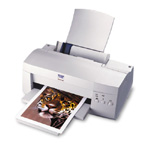Inkjet Brief History
Inkjet printers have been on the market for a few years now and have been maturing at a very rapid rate. I still remember the days of the Canon BJ-200ex, which at the time, it was a decent little printer, but it is absolutely out of date now, considering the advancements in inkjet technology. Epson has been around for a very long time and has a lengthy history in the printer business. One of their first printers was the TX-80, an impact dot matrix printer (remember those days when you needed a 200 Watt stereo cranked to drown out your printer?) brought out in 1978. Since then, they have produced countless printers; and in 1994, they started the Stylus line with the Epson Stylus Color. Today, Epson's newest offering is the Stylus 900, which Epson claims to be the fastest color inkjet on the market today.
Inkjet Technology
The technology in these printers has been evolving over the years, and Epson has been neck and neck with the best of them. Unlike many other manufacturers that use a thermal printing method, Epson uses their own technology, termed "Micro Piezo". "Micro Piezo" technology uses electronic impulses to force the ink through the print head onto the paper, resulting in crisp dots that form sharper images and text. Now, how is this different than most of the other manufacturers'?. Well most of the others use the thermal method, which means boiling the ink and then forcing it through the print head, resulting in some stray bits of ink or "splattering". The image below depicts the difference between the two technologies.
Fig 1.0 - Technology Difference |
Techno-babble
| Now, to wade through some of the techno-babble. Epson uses the term Picture PerfectTM imaging system in their write up on the Stylus 900. This is simply the term to describe the technologies that the Stylus 900 uses to produce its output. |  |
| The Picture PerfectTM system is made up of Epson's Micro Piezo technology, AcuPhoto HalftoningTM, and its quick drying ink. AcuPhoto HalftoningTM, which is built into Epson's Drivers, gives the printer the ability to decide what the best pattern is in which to spray the dots onto the paper, resulting in the best possible image quality. Sounds like a lot of marketing fluff? Maybe. But there is no question that the quality that comes out of this printer is outstanding, both in black and white, and especially color. Click here to view an image I printed from the Stylus 900 and then scanned in at 300ppi. The original looks even better. The quick-drying ink is very impressive and is exclusive to Epson's printers. Immediately after printing a color image on photo paper, it was dry. This holds true with printing black and white documents. This is quite impressive, since I constantly had problems with my old HP printer; that when you touched the paper against the printer as you handled it, the ink would smudge. | |











4 Comments
View All Comments
not2bad - Sunday, July 7, 2013 - link
<p>Recently there have been issues with Epson cartridges not being recognised bythe printer. There is a fine article about this on the
<a href="http://dealo.com.au/installing-Epson-cartridges-ex...
blog</a> </p>
not2bad - Sunday, July 7, 2013 - link
Recently there have been issues with Epson cartridges not being recognized bythe printer. There is a fine article about this on the
http://dealo.com.au/installing-Epson-cartridges-ex...
angelinaroses144 - Wednesday, December 27, 2017 - link
Recently there have been issues with Epson cartridges not being recognised bythe printer, You May Like to check <a href="https://www.epsondownload.net/epson-xp-420/"&... XP 420 Software</a>
johnnicholas_005 - Wednesday, January 20, 2021 - link
Epson printers are best, fast, and easy to use, if your are using an Epson printer but facing Epson wf-3640 error code 0x97 then follow some simple steps to download the latest printer drivers. - https://wearableworld.co/error-code-0x97/